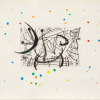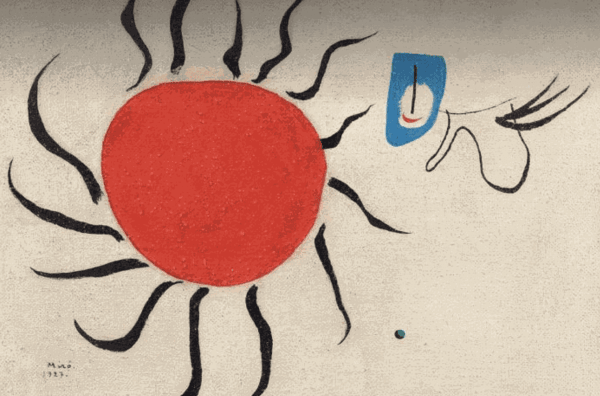Joan Miró
Joan Miró (1893 - 1983) was born in Barcelona, Spain. At the age of 14 he studied at the Barcelona School of Commerce, simultaneously taking classes at the Barcelona Arts and Crafts School. After completing his studies he took a position as a clerk. However, after suffering a nervous breakdown he left his job and resumed his art studies, attending Francesc Galí Escola d'Art in Barcelona from 1912 to 1915. Miró had his first solo show in Barcelona in 1918.
In 1920 Miró made his first trip to Paris, where he took a studio, dividing his time between Paris and Spain. In 1924 he met André Breton, and was one of the first artists to join the Surrealist group, contributing to the development of 'automatism'. Miro used found images, fragments of words or earlier sketches as the starting point for a work.
At the height of the Spanish Civil War in 1937 Miró created an anti-war mural for the Paris World Fair, which was shown alongside Picasso's Guernica. Miró's first major museum retrospective was held at the Museum of Modern Art, New York, in 1941. After the war, Miró gained international recognition as he continued to experiment freely with different mediums, including ceramics, printmaking, book illustration, and sculpture. His work was included in the first Documenta exhibition in Kassel in 1955 and in 1958 Miró received the Guggenheim International Award for his murals in the UNESCO building in Paris.
In 1929 Miró began experimenting with lithography and by 1933 made his first etchings. He described his printmaking as engraving the plate with a needle in an automatic way, without any sort of control. Miro went on to develop his own distinctive lyrical style, winning the Grand Prize for Graphic Work at the Venice Biennale in 1954. A major breakthrough for his graphic work came when he was introduced to the carborundum printmaking process in 1967. Miró found that by combining this new technique with other etching methods, especially aquatint, he could invent 'images to rival any painting'. The importance of his carborundum prints, made between 1967 and 1969, was recognised by the Museum of Modern Art, New York, in 1970 with a dedicated exhibition that toured to several US venues. Printmaking was an integral part of Miró's practice; he devoted himself primarily to the medium in the final decade of his life.
In 1975 Miro set up the Fundació Joan Miró in Barcelona as a centre for the study and exhibition of contemporary art. During Miró's lifetime retrospectives took place at the Musée National d'Art Moderne, Paris (1962); Grand Palais, Paris (1974) and in 1978 the Musée National d'Art Moderne, Paris, exhibited over five hundred works in a major retrospective of his drawings. His work is held by almost every major museum in the world.
Joan Miró died aged 90 in 1983, in Palma de Mallorca, Spain.











